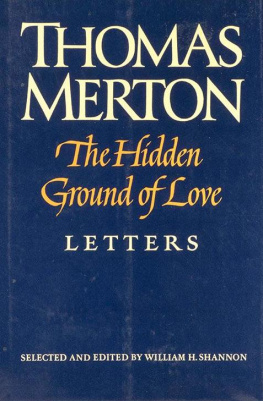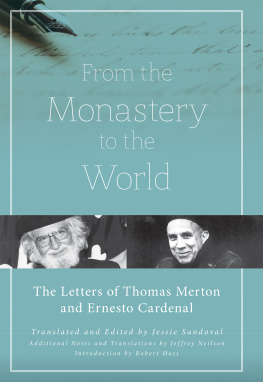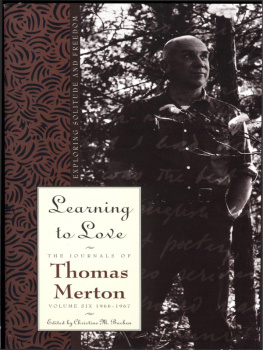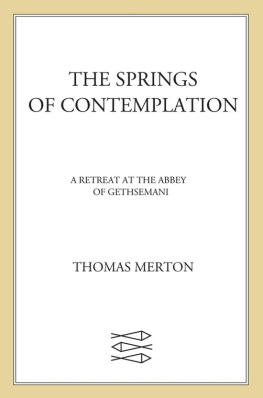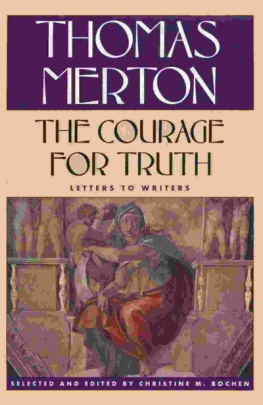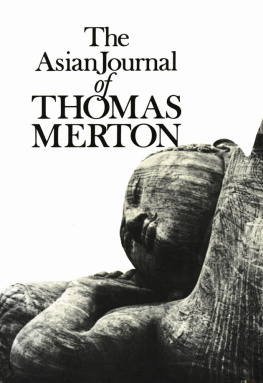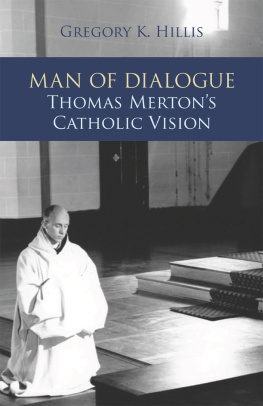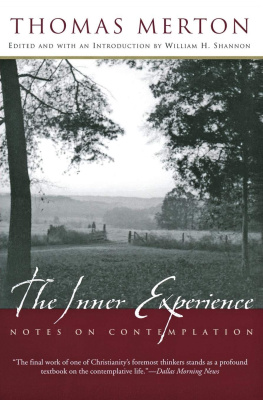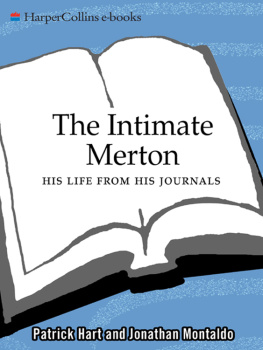Letters are valuable and entertaining in proportion to the wit and ability, and above all the imprudence, of those who write them. Honest letters are more informative, more amusing, more pathetic, more vital than any considered autobiography. Of all documents, these are the most essentially human.
C. E. VULLIAMY
When Thomas Merton made the decision to enter the Abbey of Gethsemani on December 10, 1941, to test whether or not he had a monastic vocation, he brought with him into the monastery all the instincts of a writer. He knew he was bringing them, as he revealed in The Seven Storey Mountain . He had in fact already produced a not inconsiderable amount of writing, though most of it was unpublished. Yet he was preparedat least so he thought in his initial enthusiasm for Trappist lifeto sacrifice his writing talents to the higher calling of being a contemplative. It came as a surprise to him (and perhaps a secret relief that he might not have admitted to himself) when his Superiors asked him to make no such sacrifice. On the contrary, they insisted that he keep on writing.
Though entrance into the monastery did not cost him his gift of writing, it did modify the direction his writing would take. Being a monk ruled out one kind of writingfictionhe had long been drawn to. It can scarcely be said, however, that by becoming a monk he had given up a promising career as a novelist. Four of his novels had been rejected by Robert Giroux, then a young editor at Harcourt, Brace and Company, to whom Mertons literary agent, Naomi Burton, had sent them. Giroux, who had known and published Merton as an undergraduate at Columbia College, concluded that the novels were too obviously versions of the authors unresolved struggles to find meaning in his own life. This rejection of his novels because they were masked autobiography had something of the prophetic about it. For it was a book of undisguised autobiography, The Seven Storey Mountain , that established once and for all his reputation as a writer. Its success may well have released Merton from his attraction to fiction and turned him toward a form of writing more congenial to his talent.
The Seven Storey Mountain was not only a memorable success: it was an augury of what was to come. In writing it, Merton found himself as an author, and the best writings he produced thereafter are those which, in one way or another, are autobiography. He was at his best in sharing his experiences with others. He recognized this. When he received the first copy of Seeds of Contemplation , he recorded in The Sign of Jonas: Every book I write is a mirror of my own character and conscience.
When the fan mail began to pile up as he became well known, and the circle of friends with whom he corresponded grew wider and wider, Thomas Merton became very adept in a literary form that is essentially autobiography in miniatureletter writing. Early in his writing career, Merton had been advised by Evelyn Waugh, who edited the British edition of his autobiography under the title Elected Silence , to put books aside and write serious letters and to make an art of it. Understandably, Mertons Superiors did not take kindly to this suggestion. Trappists wrote few letters; letter writing was not a part of their tradition. Yet, tradition notwithstanding, Mertons correspondence during his years in the monastery, and especially during the 1960s, became so extensive that by itself it would establish him as a writer of distinction.
He wrote hundreds of letters. In sheer quantity they almost rival his published works. At the Thomas Merton Studies Center at Bellarmine College in Louisville, Kentucky, there are some 3,500 letters addressed to well over a thousand correspondents. Nor does this tell the whole story, since more and more letters continue to turn up from the people to whom Merton wrote, or from their estates.
The scope and variety of his correspondents are staggering. He wrote to poets and heads of states; to popes, bishops, priests, religious and lay people; to monks, rabbis, and Zen masters; to Catholics, Protestants, Anglicans, Orthodox Christians, and Jews; to Buddhists, Hindus, and Sufis; to literary agents and publishers; to theologians and social activists; to old friends and young ones, too.
The range and contents of his letters are almost as diverse as the number of his correspondents. He wrote about Allah, Anglicanism, Asia, the Bible, the Blessed Virgin, Buddhism, China, Christ, Christendom, Church, conscience, contemplation, and the cold war; about Eckhart, ecumenism, God, happiness, his hermitage, and his hospital interludes; about illusions, Islam, John of the Cross, Julian of Norwich, Martin Luther King, Jr., the Koran, Latin America, liturgy, the love of God, poetry, political tyranny, precursors of Christ, prophets, psalms, silence, solitude, and sobornost ; about technology, Trinity, unity, the will of God, his own writings. The subjects of his letters parallel, and often shed light on, the wide variety of topics in his published articles and books.
But there is quality, too. Many of the letters are skillfully, if almost always hurriedly, crafted. One has the feeling that letter writing was not for him the chore that it often is for others. He seems to have enjoyed it as a serious literary endeavor. A considerable number of the letters could stand alone as brief and insightful essays on the topics they deal with. The care he took, at least during the 1960s, and especially from 1963 on, to preserve his letters (both his own and those written to him) suggests that he had a premonition of their importance.
Their importance can scarcely be overestimated. They reveal an aspect of his character and thought that does not appear, at least with the same clarity and personal touch, in his published works. This is true not only because the very nature of letter writing tends to make it more personal but also because he wrote with much greater freedom in his letters than in his published works. Almost to the last, the things he wrote for publication were carefully scrutinized by the censors of his Order and of the Church. Their chief concern (especially that of the Cistercian censors) was that Mertons writings conform to the image of what a Trappist monk was expected to be. The problem of course was that, by the 1960s at least, Merton had ceased to be a typical Trappist monk (if indeed he had ever been). On May 5, 1967, with his characteristic flair for paradox, he wrote to Rosemary Radford Ruether: I am now convinced that the first way to be a decent monk is to be a non-monk and an anti-monk, so far as the image goes. Yet he was convinced that he could do this only by remaining a monk. For in this same letter he goes on to reject Ruethers suggestion that the logic of his stance on social issues called for him to leave the monastery and the hermitage and come out into the real world to do battle with the principalities and powers. I am certainly quite definite, he wrote, about wanting to stay in the bushes, provided I can make some sort of noises that will reach my offbeat friends. It was these noises and the offbeat friends that upset and riled the censors. That is why he could make the noises and reach the offbeat friends more readily through his letters than through his published works.
Yet it would be a mistake to think that Merton delighted in being different and saying what was startling and offbeat (though it must be said that at times he was not above this). He was essentially a man of tradition, striving to recover authentic Christian and monastic values in a time of change and upheaval, during which he often read the signs of the times better and more clearly than others. He never claimed to have the answers to all questions. He did feel certain that he had some of the right questions; and he probed them relentlessly, with a greater sense of freedom in his letters than elsewhere. He wrote at a time when the very foundations of Christian life and culture were being shaken. One of the reasons he was sometimes misunderstood was that he was doing a bit of the shaking himself.



